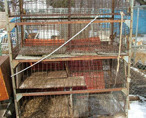 issue |
issue > puppy/kitten mills > history
KEY MESSAGE: Commercial dog and cat breeding got its start in the 1940s. It’s concentrated in the Midwest.
Photo from a breeder/farmer in Becker County in 1992. 275 dogs were seized. Farmer stated: "I was trying to get out of diary and into dogs because the dogs were easier to make money from." (Note hair and skin removed from back of dog due to small caging.)
HISTORY The ‘commercial’ breeding of dogs and cats (i.e. mass production of puppies and kittens for sale to retail stores or directly to consumers) started after World War II (1945). To help poor farmers supplement their income, the U.S. Government, through the United States Department of Agriculture (USDA), encouraged farmers to raise dogs, even though many farmers lacked a knowledge of canine health. Many of these farms were located in the Midwest. The map below shows the concentration of USDA-licensed breeders and dealers in the nation. Red marks the states with the most breeders and brokers.
Some farmers started breeding, keeping dogs and cats in existing rabbit hutches or chicken pens. Animal brokers and carriers also ‘saw money’, and set up a distribution system for transport and sales. Soon major department stores and pet shops across the United States were selling puppies and kittens. Even novelty songs were written romancing the puppies in pet stores. In 1952, Bob Merrill wrote “How much is that doggie in the window? The one with the waggley tail? How much is that doggie in the window? I do hope that doggie’s for sale.” Consumers were, and still are, unaware of where many puppies are produced and in what conditions.
INDUSTRY GROWTH The Humane Society of the United States (HSUS) estimates there are approximately 10,000 puppy mills (licensed and unlicensed) in the United States. It’s also estimated that over 2 millions puppies sold annually originated in puppy mills — USDA licensed and non-USDA licensed. For further puppy mill research (compiled by HSUS), including puppy mills facts and figures, severe USDA violations and other items, go to: Dog and cat breeders and brokers who are licensed by the USDA are inspected by the USDA and required to follow Animal Welfare Act standards. Violations (those seen and recorded) are reported on USDA inspection reports - though the USDA has, in recent years, radically lowered its posting of violations and photos taken. The ASPCA has created a website with some photos and videos (see link below). Animal Folks has, for years, also requested these photos through FOIA for use in cases where animal cruelty is suspected.
|
 |
"));